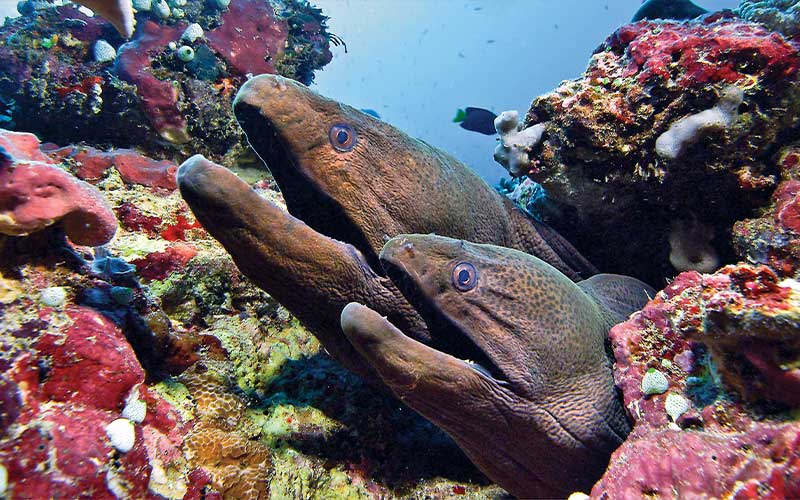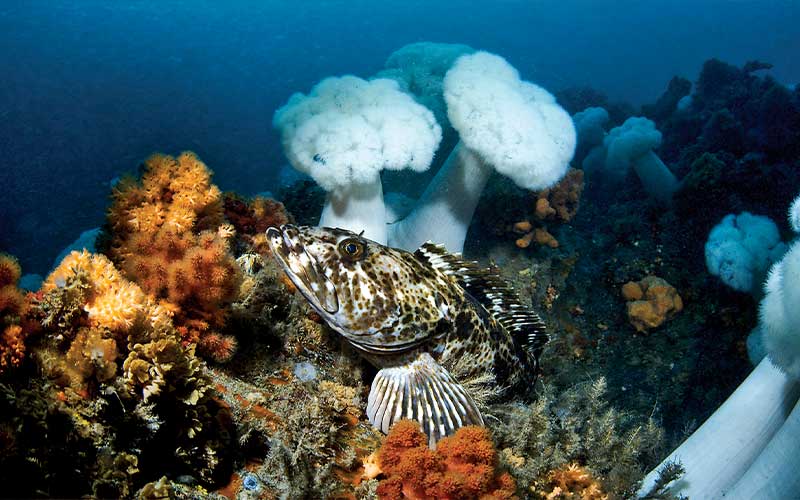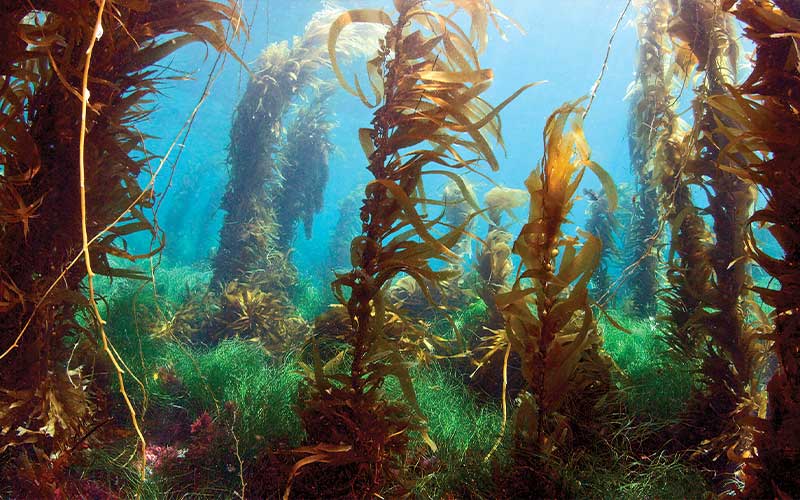I used to struggle to decide whether to take my movie camera or still camera on my next dive. Today I capture still images and motion pictures simultaneously with a single camera. Many others do, too. I get stills from my video camera, where probably far more others will get video from their digital SLR cameras. The point is, convergence is upon us.
My camera is the RED One, a digital cinema camera. It captures 9-megapixel digital raw images at up to 30 frames per second, with each of these raw frames the resolution of a high-quality digital still camera. Operating at 24 or 30 frames per second, the RED One also produces motion pictures that are arguably four times the resolution of broadcast high definition (HD).
The RED One sparked a revolution in image capture technology, just now being realized by professional and amateur photographers and filmmakers. Most new high-end imaging devices will capture both still and motion pictures at
professional-level qualities, and as the revolution progresses, what distinguishes a cinematographer from a still photographer will no longer be the hardware. It will be a cameraman’s technique and how the imaging device is configured.

A few years ago, camera manufacturers began offering a “live view” feature on their top-of-the-line still cameras. This feature allowed still photographers the option of composing their image either through the optical viewfinder or an LCD screen at the back of the camera. To adjust focus, this LCD screen had to be very high resolution; it had to be HD. Since these LCD screens required an HD video signal, manufacturers realized they could simply provide a “video record” feature on their cameras. Presto! The still camera became an HD movie camera.
The game-changer happened when Canon released the 5D Mark II digital SLR in 2008. In addition to being capable of 21-megapixel still images, the camera can output full-resolution HD at 1,080 vertical lines of resolution. Today, Canon digital still cameras are being used to make episodes of popular television dramas and even feature films. Instead of using HD broadcast cameras that cost hundreds of thousands of dollars, directors are using $2,500 still cameras. Many are likewise using the RED One, which remains much less expensive than a broadcast HD camera. Incredibly, the RED One camera is more frequently used today to make IMAX movies than the 70mm analog cinema film upon which the franchise was founded.
Convergence Challenge 1: Shutter Speed
There are still fundamental differences between still photography and cinematography — shutter speed being one example. To capture sharp images of moving subjects, a still photographer uses fast shutter speeds to freeze motion, whereas cinematographers generally use much slower shutter speeds, specifically to avoid action looking “jittery.” Motion picture cameras are usually set between 1/24th to 1/60th of a second, and at these slower speeds the still frames of fast-moving subjects may be significantly blurred. This motion blur, however, makes motion-picture action appear smooth.

Convergence Challenge 2: Artificial Light
Another major difference between still photography and cinematography is the way artificial light is used. Still photographers use strobes, while cinematographers use motion picture lights. An underwater strobe produces a very bright and wide pattern of light, but the flash might last only 1/4000th of a second. To approach the width and intensity of an underwater strobe, a cinematographer needs a massive underwater movie light powered through a heavy cable connected to a generator on the surface — not a typical sport diving solution! Most of the motion pictures I have made were lit with more than 2,000 watts of light, powered by 220-volt current. It is quite a production to swim such a lighting system around, and even that much power fails to produce the quality of light created by a pair of professional underwater strobes set at high power.
Underwater battery-operated movie lights are quite dim when compared with an underwater strobe. When lighting with my RED One underwater, I often mount a pair of Light and Motion LED lights on top of my Gates Deep RED housing. This produces excellent colors, as long as subjects are close and ambient light levels are not overwhelming. To achieve a good balance between a blue open-water background and a strobe-lit foreground, an underwater still photographer often uses steep upward camera angles. To get a similar look with my LED lights, I typically angle the camera down where the water is much darker so I can open the aperture and see the influence of my artificial light.

Convergence Challenge 3: Movement and Framing
There are also significant differences in the way cinematographers operate movie cameras compared with the way still photographers handle still cameras. Cinematographers remain motionless or move their cameras slowly, allowing action to develop in front of their lens. Still photographers move quickly to compose their frame for that best single image. I often look through an entire 30-second clip without finding a single frame that is composed well as a still image, though every once in a while I find a gem.

Convergence Challenge 4: Senor Size
One major consideration for those tempted to trade their HD video cameras for a digital SLR or RED One is sensor size, as it relates to depth of field. Logic implies that the larger the sensor, the better. But this is not necessarily true as far as focus goes. Both the Canon 5D Mark II and the RED One have large sensors approaching one inch or more horizontally. Most HD video cameras have sensors smaller than one-half inch, many less than one-third inch. Here’s the catch: For any given lens and aperture setting, the larger the sensor, the more shallow the depth of field.
Now imagine you are shooting a tiny macro critter with a telephoto lens. All those videographers out there capturing great images of tiny critters on their HD video cameras might be very frustrated using my RED One system. When a dive guide points out a pigmy seahorse to me, I simply shrug, write “cute bug” on my slate and swim away. The depth of field is simply too difficult at macro magnifications on a moving subject. On the other hand, topside cinematographers seem to be enamored of the shallow depth of field and rendering of background detail (bokeh, or blur) that comes from the Canon full-frame sensor.
I consider myself primarily a cinematographer. But when looking through the clips produced by my RED One, I enjoy searching for single frames that may be acceptable still images. Using the RED Alert! software on my laptop, I can adjust contrast, saturation and white balance of the raw frame. Then I click a button to create a 9-megapixel TIFF image saved to my desktop. If the image is good enough, I can save a copy to my still image library. To me, it’s like getting two birds with one stone. Of course, my stone costs $17,500 for the camera, another $5,000 for lenses, batteries and other necessary accoutrements, plus $25,000 for my Gates Deep RED housing. But my RED equipment is still $160,000 less than the Sony equipment it replaced. For those seeking to achieve HD video via the digital SLR route, excellent solutions are now available in camera bodies like the Canon T2i, costing less than $900.

What’s next? I predict that the next stage of this revolution will be the release of SLR digital still cameras that capture motion pictures and still images simultaneously in an extraordinarily high-resolution raw format at a cost well under $5,000. And, a few years later, I suspect I’ll be making IMAX 3-D films with a pair of waterproof smart phones stuck together with duct tape. Well, maybe not, but that sure would have saved us money on shipping a 1,300-pound underwater camera system all the way to Papua New Guinea to film Under the Sea 3-D!
Note: All the images in this article are single frames grabbed from Howard Hall’s RED One digital video camera, as is this issue’s cover shot of sailfish in silhouette. This demonstrates the impressive quality of still capture from this video system. But even though each individual frame may be the equivalent of a 9-megapixel still camera in terms of quality, lighting and shutter speed selection to accommodate both still and video remain obstacles to overcome.
© Alert Diver — Q3 Summer 2010